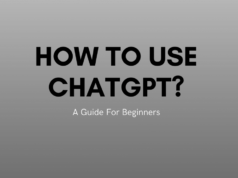In recent years, artificial intelligence has made significant strides. And one of the most exciting developments in AI technology is ChatGPT. With the increasing buzz surrounding its capabilities, many are asking: what is ChatGPT?
At its core, ChatGPT is an advanced AI language model developed by OpenAI. This model, powered by cutting-edge machine learning techniques, is capable of understanding and generating human-like text. From answering questions to composing emails, creating essays, and even engaging in casual conversations, ChatGPT has become a game-changer in the AI world.

In this article, we’ll dive into what ChatGPT is, how it works, its applications, and address the frequent question: Is ChatGPT down? We’ll also explore its key features, potential limitations. And how it can impact industries ranging from customer service to content creation.
Understanding The Basics
ChatGPT is a chatbot powered by GPT-3, an AI language model developed by OpenAI. The “GPT” stands for Generative Pre-trained Transformer. Which is a type of neural network architecture used in natural language processing (NLP). Unlike traditional chatbots that rely on pre-programmed responses. ChatGPT generates answers based on context, learning from vast amounts of data, including books, websites, and other publicly available texts.
This makes it highly versatile in performing a variety of tasks such as:
- Answering questions: ChatGPT can provide detailed responses to questions, whether they’re about history, science, or current events.
- Content creation: From blog posts to creative writing, the service can assist in generating text-based content quickly and efficiently.
- Customer service: Many businesses have implemented this bot to handle customer inquiries, reducing the workload of human agents.
- Language translation: It can also help in translating languages, making communication easier across borders.
The Evolution of ChatGPT: From GPT-3 to GPT-5
The first iteration of ChatGPT was based on GPT-3, which was already capable of producing human-like text. But the advancements didn’t stop there. OpenAI has continued to refine and enhance the model, leading to the release of GPT-4 and GPT-5.
- GPT-3 laid the groundwork for language generation, handling a variety of tasks with impressive results, but with some limitations in handling more nuanced contexts.
- GPT-4 improved upon these capabilities, making it more reliable for tasks that require deeper understanding, such as summarizing complex documents or offering technical support.
- GPT-5, which is set to further enhance the model’s capabilities, brings improvements in reasoning, memory, and multi-turn conversations.
These advancements are part of OpenAI’s ongoing mission to create more intelligent and adaptable AI systems that can provide real value in various sectors.

How Does ChatGPT Work?
ChatGPT functions by leveraging deep learning techniques to predict the next word or phrase in a sequence of text. Here’s a simplified breakdown of how it works:
- Pre-training: Initially, the model is trained on vast amounts of data. This process involves feeding it books, articles, and other publicly available text to help the model understand language patterns, grammar, and context.
- Fine-tuning: After pre-training, ChatGPT undergoes a process called fine-tuning, where it is trained on specific datasets with human feedback. This allows the model to improve its responses, making them more accurate and contextually relevant.
- Prediction: When you interact with ChatGPT, it uses its training to predict the most likely response based on the input it receives. It does so by analyzing the context of your question or statement, determining the most probable next word or phrase, and generating a coherent and meaningful reply.
ChatGPT Applications: Where It’s Used
ChatGPT’s versatility means it’s used in a wide range of applications:
1. Customer Service
ChatGPT is widely used in customer support systems. With its ability to understand and respond to queries in natural language, businesses use it to enhance customer experience, offering instant support across various platforms.
2. Content Generation
Content creators use this service to write articles, blogs, and social media posts. Its ability to generate human-like text quickly has made it a valuable tool for content marketers and bloggers.
3. Language Learning
ChatGPT can assist in language learning by providing real-time conversations, helping learners practice and refine their skills. This has revolutionized how people approach language acquisition, offering an interactive way to learn new languages.
4. Code Generation
Developers use it to generate code snippets or even entire programs. This AI model can understand coding languages and offer solutions, making it a valuable tool for software development.
5. Personal Assistants
ChatGPT can be used as a personal assistant to help with daily tasks such as scheduling, reminders, and even providing suggestions for activities based on your preferences.

Common Questions: Is ChatGPT Down?
One of the most common queries users ask is “Is ChatGPT down?” Since it has been a online service, there can be occasional downtimes, usually due to maintenance or high traffic on the servers. Users may experience delays or temporary unavailability, but OpenAI typically works to resolve these issues swiftly.
If you ever face an issue where ChatGPT is down, it’s a good idea to check the OpenAI status page or social media channels for updates. Alternatively, clearing your browser cache or restarting your application may resolve minor connectivity issues.
Potential Limitations of ChatGPT
While ChatGPT is powerful, it’s not without its limitations:
- Context Limitations: It may struggle with understanding highly specific or niche topics if it’s not adequately trained on that information.
- Bias in Responses: Like many AI systems, ChatGPT can inherit biases present in the training data, which could affect its responses.
- Lack of Emotional Intelligence: Although it can mimic human conversations, it lacks true emotional intelligence and may sometimes miss the nuances of human emotion.

The Future of ChatGPT
The future of ChatGPT is incredibly promising. With continuous improvements in its underlying technology, we can expect it to become even more intelligent and useful across industries. In fact, OpenAI is already working on integrating ChatGPT with multimodal AI systems, allowing it to interact with images and videos, opening up new possibilities for applications like education, healthcare, and creative arts.
Conclusion
In conclusion, ChatGPT is an advanced AI language model with a wide range of capabilities. From enhancing customer service to helping with content creation, it’s transforming industries and providing new opportunities for individuals and businesses alike. While it’s not perfect and has its limitations, the future of ChatGPT looks bright, with continuous improvements being made.







